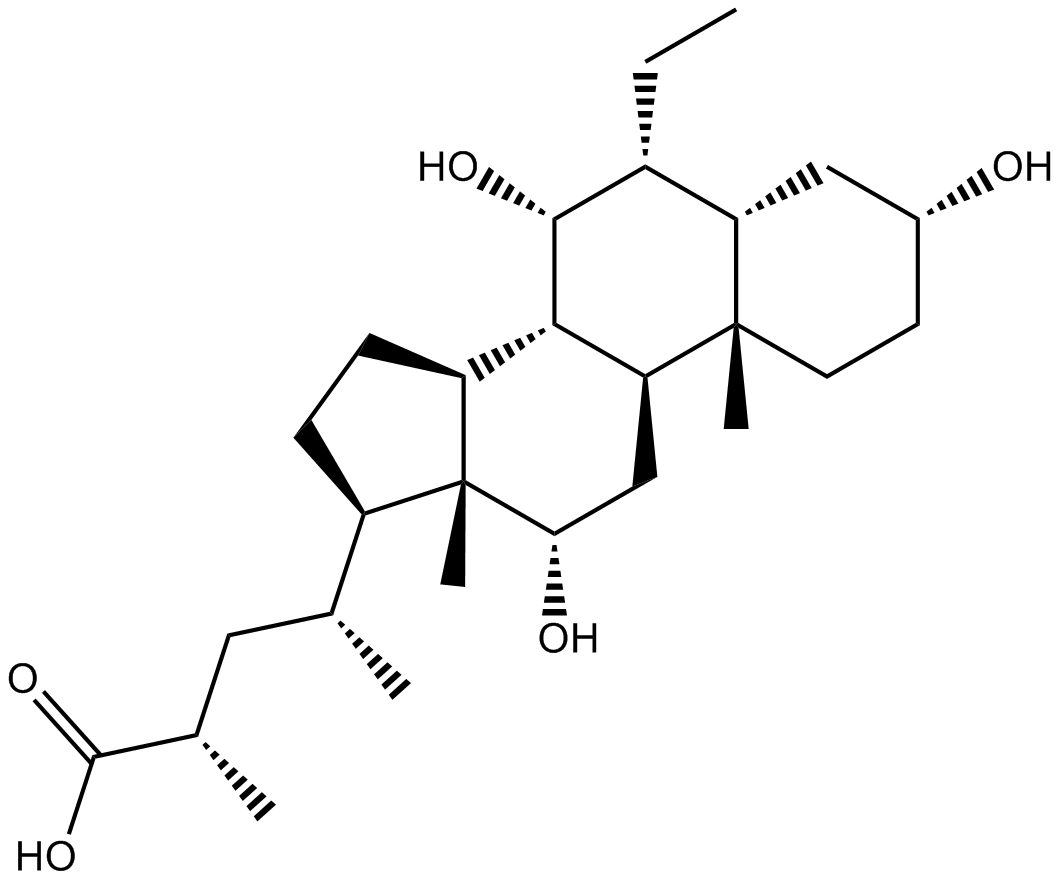INT-777 (Synonyms: 6-EMCA, S-EMCA, HY-15677) |
| Katalog-Nr.GC13681 |
INT-777 ist ein neuartiger, spezifischer halbsynthetischer TGR5-Agonist, der zur Linderung von Kardiomyozytenverletzungen und Verbesserung kognitiver Beeinträchtigungen und synaptischer Dysfunktionen im Mausmodell der Alzheimer-Krankheit eingesetzt wird.
Products are for research use only. Not for human use. We do not sell to patients.

Cas No.: 1199796-29-6
Sample solution is provided at 25 µL, 10mM.
INT-777 is a novel specific semisynthetic TGR5 agonist used for alleviating cardiomyocyte injury and improving cognitive impairment and synaptic dysfunction in mice model of AD.[1][2]
In vitro, INT-777 induced a dose-dependent (10 μM to 60 μM) decrease in Isc, when INT-777 added on the serosal side of seromuscular stripped distal colon segments in Ussing chambers.[5] In vitro experiment it shown that treatment with 25 μm of INT-777 for 48 h in αTC1-6 cells as well as in mouse and human islets under high glucose conditions obviously increased PC1 mRNA. However, INT-777 (25 μm) had no effect on PC1 mRNA in cells exposed to low glucose conditions.[6] In vitro, combination 100 ng/ml LPS with treatment of 30 μM INT-777 dramatically decreased the transient increase in mRNA levels for Tnfα, monocyte chemoattractant protein-1 (Mcp-1), Il-6 and Il-1β in macrophages.[7]
In vivo efficacy test it indicated that treatment with 30μg/kg of INT-777 dramatically reduced NLRP3-ASC inflammasome activation in microglia, decreased brain edema and neuroinflammation, resulted in improved short-term neurobehavioral functions at 24 h after subarachnoid hemorrhage.[3] In vivo study it suggested that mice were treated with 1.5 or 3.0 μg/mouse INT-777, single intracerebroventricular (i.c.v.) injection of LPS obviously induced mouse behavioral impairments in Morris water maze, novel object recognition, and Y-maze avoidance tests were ameliorated.[7].
References:
[1]. Wu X, et al. Neuroprotective effects of INT-777 against Aβ1-42-induced cognitive impairment, neuroinflammation, apoptosis, and synaptic dysfunction in mice. Brain Behav Immun. 2018 Oct;73:533-545.
[2]. Deng L, et al. Activation of TGR5 Partially Alleviates High Glucose-Induced Cardiomyocyte Injury by Inhibition of Inflammatory Responses and Oxidative Stress. Oxid Med Cell Longev, 2019: 6372786.
[3]. Hu X, et al. INT-777 attenuates NLRP3-ASC inflammasome-mediated neuroinflammation via TGR5/cAMP/PKA signaling pathway after subarachnoid hemorrhage in rats. Brain Behav Immun. 2021 Jan;91:587-600.
[4]. Wu X, et al. Inhibitory effect of INT-777 on lipopolysaccharide-induced cognitive impairment, neuroinflammation, apoptosis, and synaptic dysfunction in mice. Prog Neuropsychopharmacol Biol Psychiatry. 2019 Jan 10;88:360-374.
[5]. Sorrentino G, et al. Bile Acids Signal via TGR5 to Activate Intestinal Stem Cells and Epithelial Regeneration. Gastroenterology. 2020 Sep;159(3):956-968.e8.
[6]. Kumar DP, et al. Activation of Transmembrane Bile Acid Receptor TGR5 Modulates Pancreatic Islet α Cells to Promote Glucose Homeostasis. J Biol Chem. 2016 Mar 25;291(13):6626-40.
[7]. Pols TW, et al. TGR5 activation inhibits atherosclerosis by reducing macrophage inflammation and lipid loading. Cell Metab. 2011 Dec 7;14(6):747-57.
Average Rating: 5 (Based on Reviews and 28 reference(s) in Google Scholar.)
GLPBIO products are for RESEARCH USE ONLY. Please make sure your review or question is research based.
Required fields are marked with *




